Vegetable Samosas
Posted by admin on
These authentic vegetable samosas are just like what you’ll find at your favorite Indian restaurant! A flaky dough is wrapped around a spiced potato and pea filling for an irresistible appetizer.

There’s no shortage of deliciousness at Indian restaurants, from fragrant curries and biryani to chewy naan and thick, tangy lassi, but I think appetizers are one of the highlights of any trip to the buffet. First, there’s so much variety! And, of course, it all tastes amazing. Vegetable samosas are always one of my favorites, and I decided it was finally time to try to make them at home.
Is it worth it? Uh-huh.
Making samosas is one of those satisfying cooking adventures like making your own bread or flour tortillas—it takes time, but you’ll feel proud of yourself when it’s all said and done (and eaten). You’ll need to pick up some specialty ingredients from your local Indian grocery store (or Amazon), but once you have them on hand, you’ll be able to make these vegetable samosas on the regular.
And you’ll want to make them often! Because they are that good. They have a fluffy potato filling full of Indian spices, that crispy, flaky samosa exterior, and they’re so tasty, you might just want to make a meal out of samosas alone.
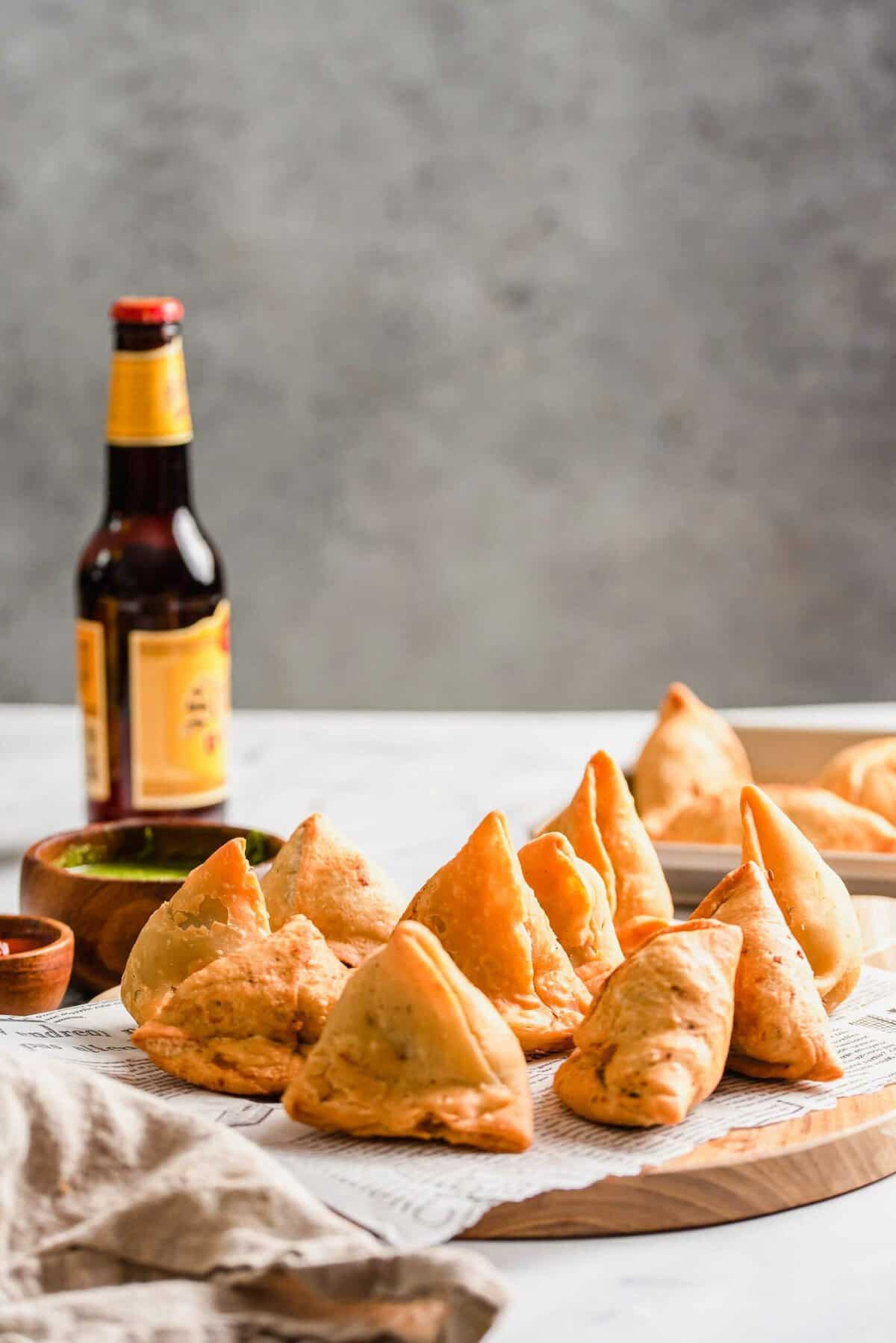
What Are Samosas Made Of?
You will need to take a trip to the Indian grocery store for this vegetable samosa recipe, but it’s worth it!
For the dough:
- All-purpose flour
- Carom seeds – These are also known as ajwain seeds. They have a pungent flavor that’s like a cross between oregano and anise.
- Salt
- Oil or ghee – Ghee is more authentic, but you can swap in a neutral-flavored oil instead.
- Water
For the filling:
- Potatoes – I recommend using Russet potatoes.
- Green peas – Frozen is best, but canned peas can be used in a pinch.
- Cumin seeds
- Fennel seeds
- Coriander seeds
- Kasuri methi – Also known as kasoori methi, or dried fenugreek leaves.
- Fresh ginger
- Green chillies – Use as much or as little as you like, depending on how spicy you want your samosas. Authentic Indian chillies are known as hari mirch, and varieties include Kashmiri, Guntur, Byadgi, Kanthari, and Bhut Jolokia. If you can’t find these, you can use a jalapeño pepper.
- Black pepper powder
- Chaat masala – This spice blend is made with dried mango powder, dried pomegranate seeds, and black salt. You can substitute this with dried mango powder, which is called amchur.
- Cilantro leaves
- Oil
- Salt
- Vegetable or canola oil – You’ll need this for frying the samosas.
Are Samosas Vegan?
If you use oil instead of ghee, this samosa recipe is vegan and dairy-free, making them perfect for anyone on a plant-based diet!
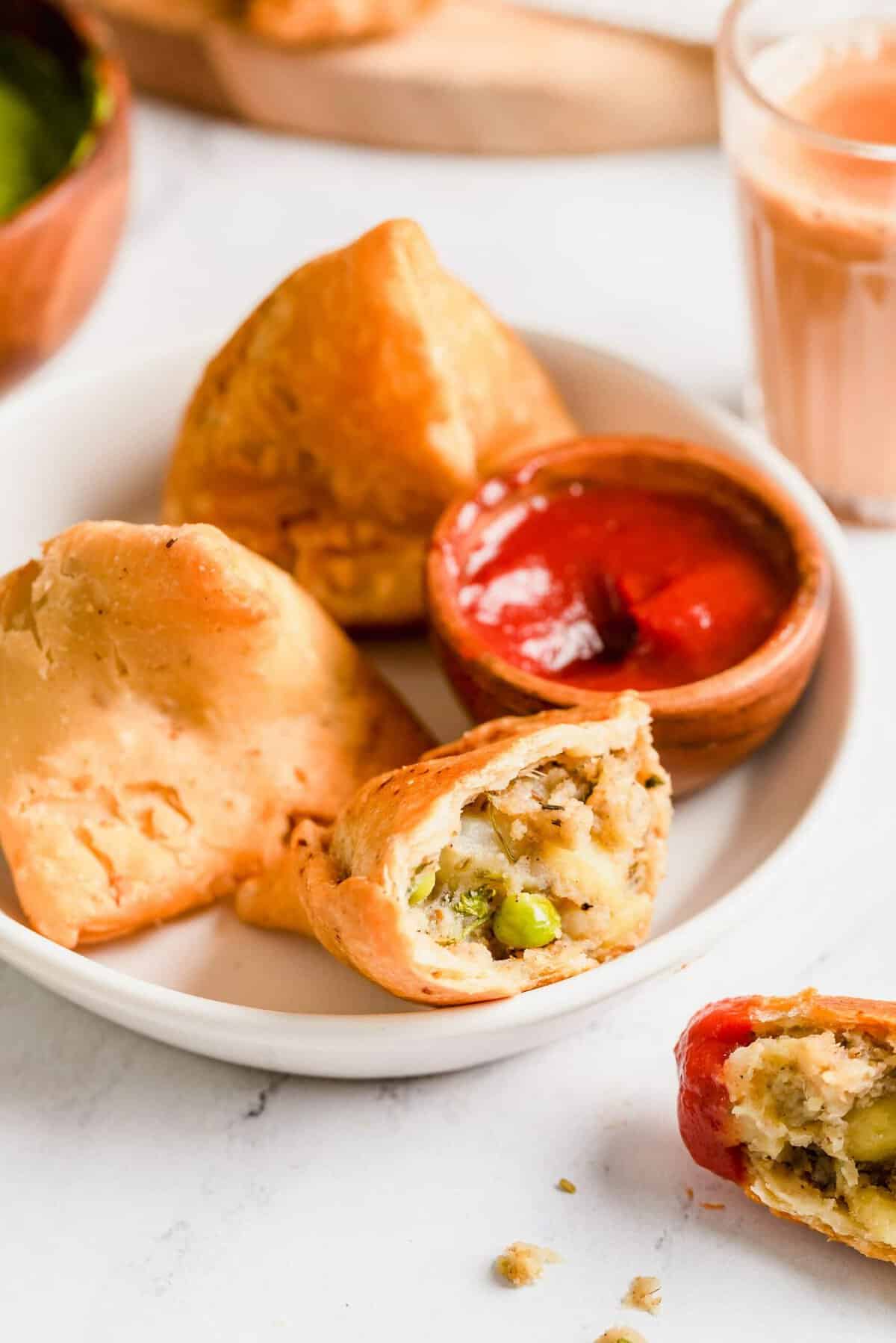
How to Make Vegetable Samosas
Ready to roll up your sleeves and make some samosas? Let’s get started!
Make the samosa dough:
Mix the dough ingredients. Whisk together the flour, salt, and carom seeds in a large bowl. Add the oil or ghee and rub them together until well-combined; the texture of the flour should look like breadcrumbs and hold together when squeezed.
Add water. Add the water little by little, until a stiff dough forms.
Rest. Cover the bowl and let the dough rest for at least 30 minutes.
Make the filling:
Prep the potatoes. Boil the potatoes until they are soft, then cut them into cubes.
Make the spice mixture. Using a mortar and pestle or a spice grinder, crush the cumin seed, coriander seeds, and fennel seeds into a somewhat coarse powder.
Cook the filling. Warm the oil in a large skillet and add the ginger and chilies. Add the crushed cumin, coriander, and fennel and sauté for a minute over medium-low heat, followed by the potatoes, green peas, and salt to taste. Stir, then add the black pepper powder, chaat masala, kasuri methi, and cilantro. Continue to cook and stir until the potatoes are toasted and the peas are softened, mashing the potatoes a bit, but leaving some chunks as well.
Finish. Remove the filling from the heat and let it cool enough that it can be handled safely.
Make the samosas:
Prepare the dough. Form a small amount of dough into a ball, then roll it into an oval shape. Use a knife to cut the oval into two halves. Take one half and apply some water to the edges. Make a cone shape with the dough by bringing together the two ends and pressing them together, forming a pocket.
Add the filling. Seal the pointed end so there’s no gap, then add about 1 1/2 tablespoon of the filling into the cone. Bring the open ends together and seal them, using water to make the dough stick together. It will now look like a triangle and the filling will be completely enclosed in the cone. Repeat with the remaining dough and filling.
Heat the oil. Pour the oil into a large pan and warm it until it’s hot enough that, when you drop a small piece of dough into it, it floats up slowly.
Cook the samosas. Carefully drop the samosas into the oil and cook them over medium-low heat until they’re golden and crispy. Turn the heat down if you see them browning quickly.
Finish. Remove the samosas from the oil and set them on a plate lined with paper towels to drain. Serve with green chutney or your favorite dipping sauce.
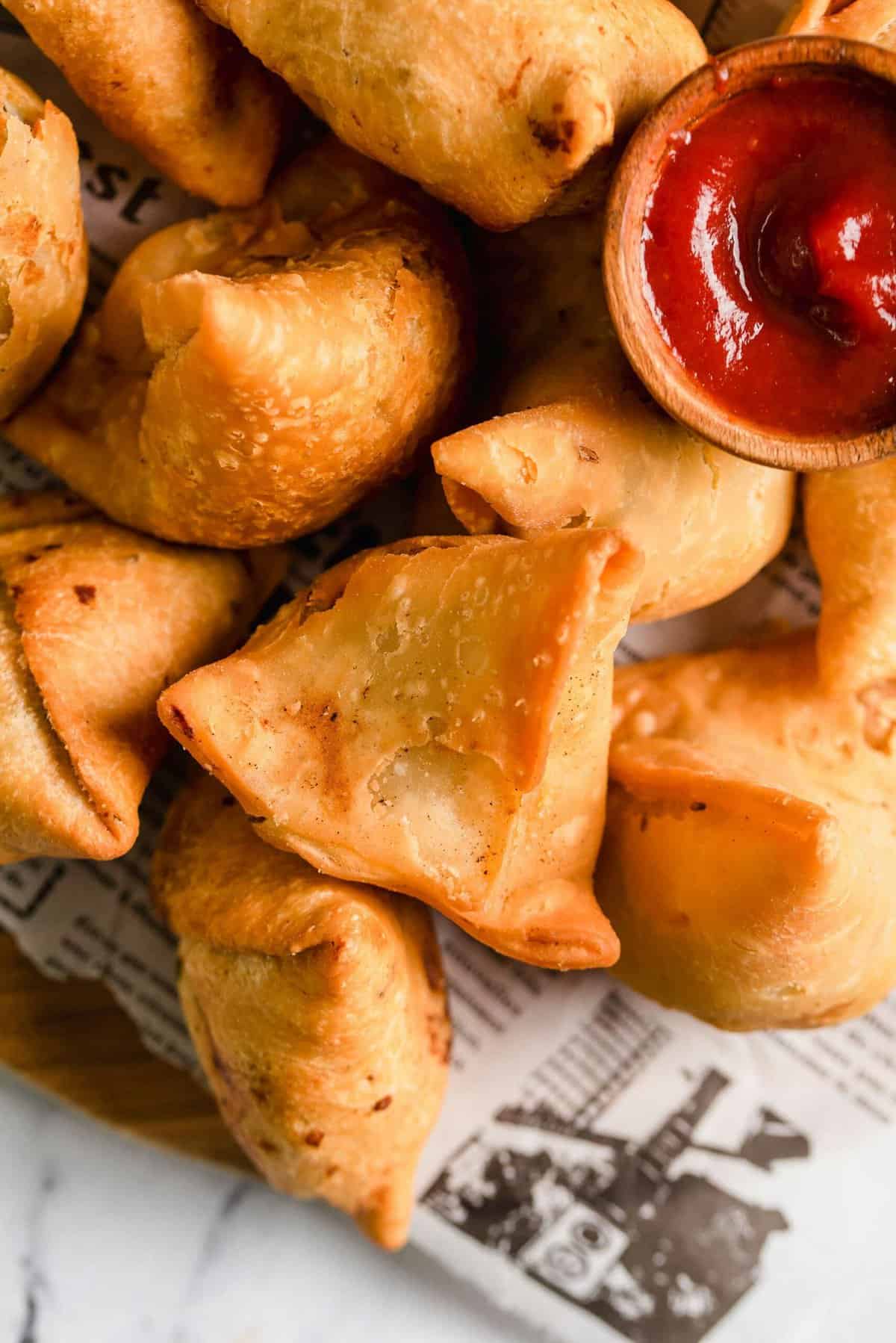
Tips for Success
Here are some hints and tips to help you make perfect vegetable samosas:
- Shortcuts for the dough. You can buy ready-made pastry in many Indian grocery stores. If you’re not worried about authenticity, you can also substitute puff pastry sheets or spring roll wrappers.
- Get a head start. Make the filling a day or two in advance so it’s ready to go when you’re going to make your samosas.
- Baking the samosas. If you prefer to skip deep frying, you can bake the samosas on a sheet pan in a 400ºF oven. Grease the sheet well and coat the samosas with oil; bake them for about 15 minutes, flipping them halfway through the cooking time. Once they’re finished baking, place them on a wire rack or a paper-towel-lined plate to cool a bit before serving.
What Kind of Sauce Goes With Samosas?
Green chutney is the most common sauce served with samosas, which is made with a combination of cilantro and mint. Other options include mango chutney, tamarind chutney, tomato chutney, or raita, which is a yogurt-based sauce.
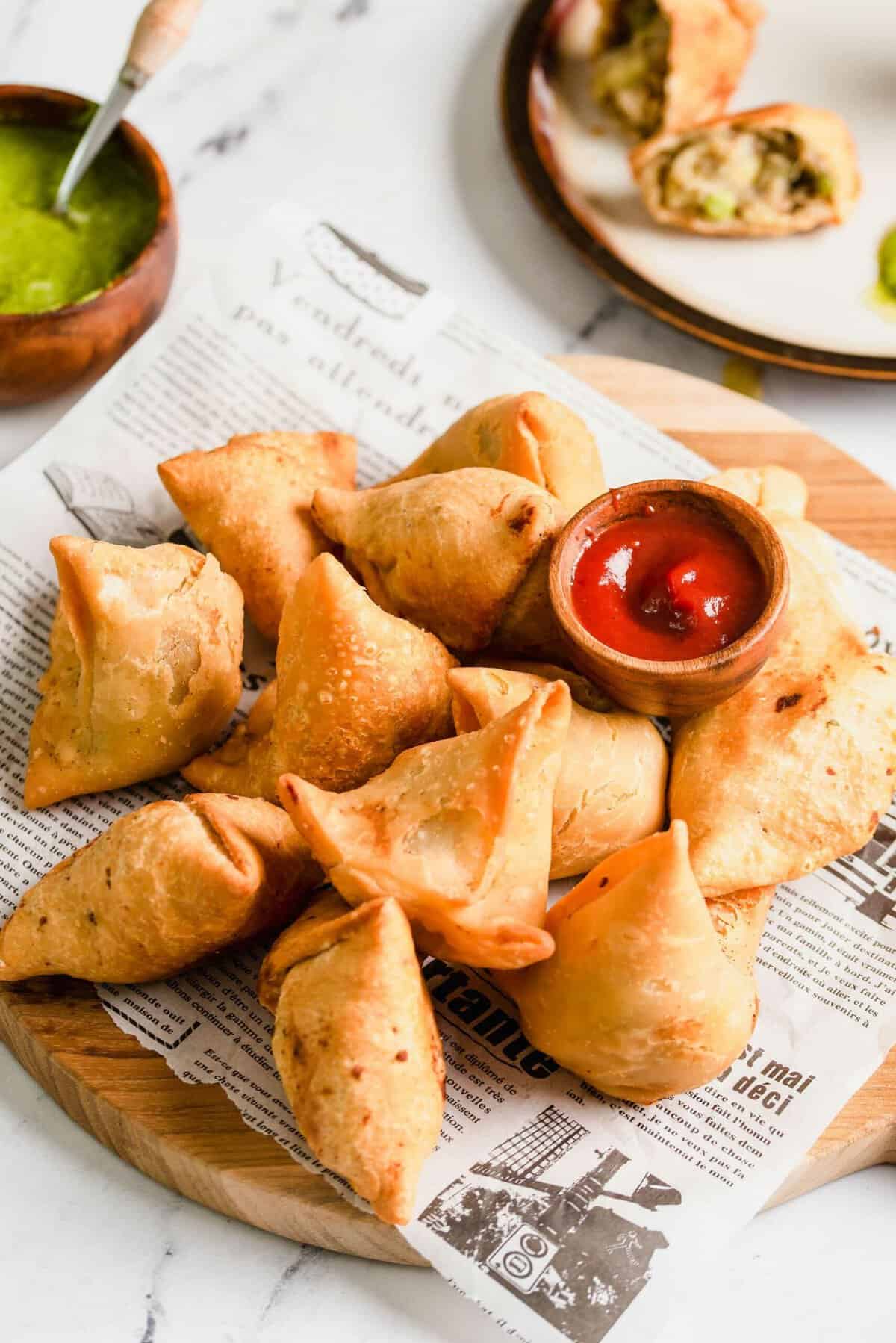
How to Store and Reheat Leftovers
Store leftovers in an airtight container in the refrigerator for 4 to 5 days. You can reheat samosas in an air fryer, in the microwave, or in a 400ºF oven until they’re warmed through.
Can This Recipe Be Frozen?
Yes, you can freeze samosas in an airtight container or freezer bag for up to 3 months. Reheat them in a 400ºF degree oven for 15 to 20 minutes (depending on their size), or until they’re warmed through.
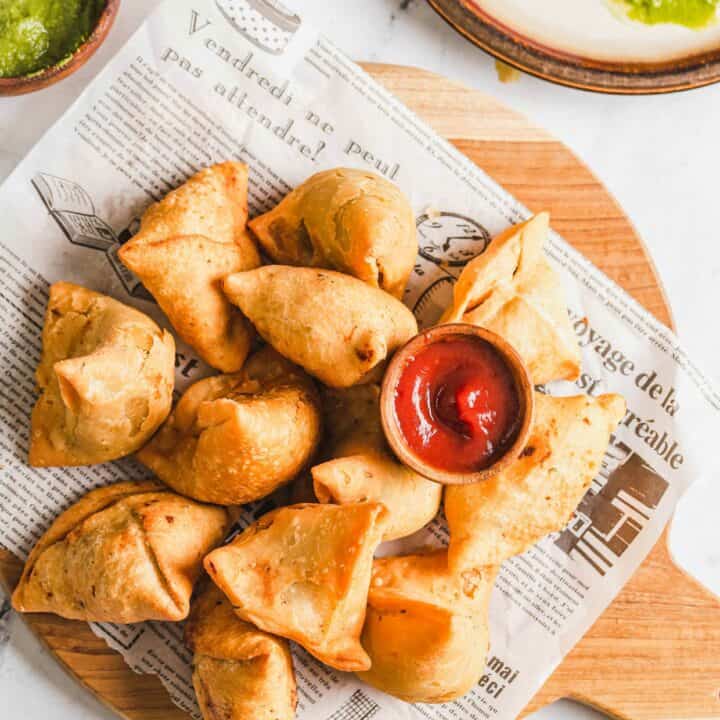
Vegetable Samosas
Ingredients
For the dough
- 2 cups all purpose flour
- 1 teaspoon carom seeds
- 1 teaspoon salt
- 4 tablespoons oil/ ghee
- Water for kneading the dough
For the filling
- 4 medium sized potatoes
- ½ cup green peas
- 1 teaspoon cumin seeds
- 1 teaspoon fennel seeds
- 2 teaspoons coriander seeds
- 1 teaspoon crushed kasuri methi
- 1 ½ teaspoon finely minced or crushed ginger
- 1–2 green chillies use as per spice levels
- ½ teaspoon black pepper powder
- 1 teaspoon chaat masala
- 1 tablespoon chopped cilantro leaves
- 1 ½ tablespoons oil
- Salt to taste
- Neutral tasting oil like vegetable or canola oil to fry the samosas.
Instructions
Make the samosa dough:
- To make the samosa dough, first take the flour, salt, carom seeds in a large bowl and mix well.
- Now add the oil or ghee to the flour and rub the flour and ghee together until the ghee is mixed well with the flour.
- The texture of the flour should look like breadcrumbs and you should be able to form a shape of sorts if you squeeze some flour in your palm.
- When the oil/ ghee is well incorporated, add the water little by little and make a stiff dough.
- When the dough is done, cover it and let it rest for at least 30 minutes.
Make the filling:
- Boil the potatoes until they are soft. You can do this in a pressure cooker/ instant pot or in a sauce pan.
- When the potatoes are done, peel the skin if you have done so already and chop them roughly into cubes and set it aside.
- Mince the ginger and green chilies and set it aside.
- In a mortar and pestle or a spice grinder, crush the cumin seed, coriander seeds, fennel seeds into a somewhat coarse powder and set it aside. (You can add the cumin seeds and fennel seeds whole and add ground coriander powder instead and it will still taste good.)
- In a skillet add the oil needed for the filling and when it becomes hot, add the ginger and green chilly, let it sizzle for a minute.
- Now add the crushed cumin, coriander and fennel and sauté for a minute in low-medium heat. Do not burn the spices.
- Quickly, add the cubes potatoes, green peas, salt to taste and mix everything well with the spices.
- Add the black pepper powder, chaat masala, kasuri methi, chopped cilantro leaves and mix well.
- Let the potatoes become slightly toasty and the peas become soft. Mash the potatoes and peas roughly as they are getting cooked, but make sure you have some potatoes chunks here and there so you get a nice bite when you eat the samosas.
- When done, switch off the stove. Let the mixture cool.
Make the samosa:
- Take some dough and make a ball.
- Roll the dough into an oval shape.
- Use a knife to cut the oval in the middle into 2.
- You will now have 2 rolled doughs that looks like the letter D and another Flipped D. (Semi circle)
- Take one of the semicircle and apply some water to the edges.
- Now make a cone shape with the dough. (To do this simple bring together the 2 ends and press them together.) You will now have a pocket of sorts to put the stuffing inside.
- Seal the pointed end so there’s no gap. The filling should not come out when you stuff it inside.
- Now add about 1 ½ tbsp or so of the filling inside the cone. You will add more or less depending on how big your cone is.
- When the potato filling is stuffed, bring the open ends together and seal them. You can use some water to make the dough stick together.
- It will now look like a triangle and the filling should be totally enclosed within the cone.
- Do the same steps for the other semi-circle and the rest of the dough. Set it aside.
- Heat a large pan with neutral tasting oil like vegetable or canola oil.
- The oil should not be too hot.
- It should be warm. When you drop a small piece of dough it should slowly float up.
- Drop the shaped samosas in the oil and cook them in low -medium heat until they look golden and crispy.
- You might have to turn the heat down if you see them browning quickly.
- When done, drain the samosas and serve them with some green chutney or your favorite dipping sauce.
Notes
- You can also get ready made pastry in Indian stores.
- For an even easier version, you can try stuffing them in puff pastry sheets. It might not be authentic but it will taste delicious nevertheless.
- You can substitute chaat masala with amchur (Dried mango powder). Both are available in Indian stores or on amazon.
- To store: Store leftovers in an airtight-container in the refrigerator for 4 to 5 days. You can reheat samosas in an air fryer, in the microwave, or in a 400ºF oven until they’re warmed through.
- To freeze: Freeze samosas in an airtight container or freezer bag for up to 3 months. Reheat them in a 400ºF degree oven for 15 to 20 minutes (depending on their size), or until they’re warmed through.
